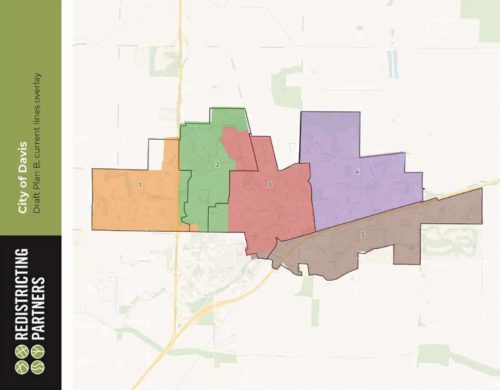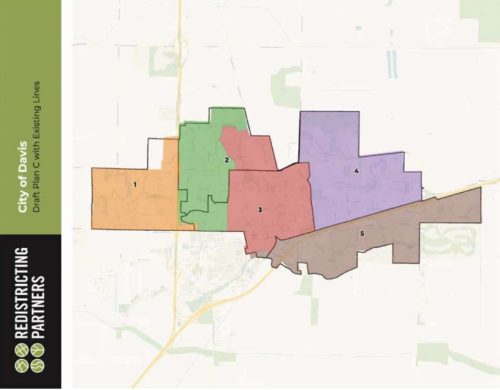

By Aleeza Khan
DAVIS, CA — The Davis City Council met on the first of February to finalize redistricting plans for the City of Davis. The plans discussed at this meeting had been updated based on previous feedback from the council on Jan. 20, 2022.
The meeting on Tuesday was the “fourth of five required public hearings to set new City Council districts based on the 2020 census information,” explained Assistant City Manager Kelly Stachowicz.
When drawing district plans, the council must adhere to the California Fair Maps Act, passed by the state legislature. This act requires that districts must be contiguous, compact, of relatively equal size, maintain “communities of interest,” and follow city and census designated boundaries.
For Davis, a community of interest is Aggie Village. In response to public testimony, the council is aiming to group Aggie Village with similar neighborhoods in the new district plans.
During the meeting on Tuesday, the council reviewed three redistricting plans—each of which push Aggie Village out of District 5 and into District 3.
Along with the Fair Maps Act, the council also factored in the amount of voting accelerations and deferrals that each plan would yield.
Chris Chaffee, the Chief Operations Officer with Redistricting Partners, presented the plans and provided an explanation for what accelerations and deferrals would mean for the people of Davis.
“In an election system where there are staggered, four-year terms with elections every two years, a redistricting can result where a person who just recently elected a representative is moved into a new district where they can again choose an elected representative,” Chaffee stated.
In other words, “their opportunity to vote has been accelerated by two years.”
On the other hand, a deferral would be “a person’s opportunity to vote has been deferred by two years.”
The council is seeking to choose a redistricting plan with the least amount of deferrals possible.
During the meeting, the council came to the consensus that Map A (as shown below) made for the best plan because it yielded the least amount of deferrals. However, council member Will Arnold expressed his concerns which kept him from voting on this version of Map A.
“There’s a couple of neighborhoods that are going to be voting with everybody on the other side of the freeway and not most of what they consider their neighborhood” Arnold argued.
Referring to the border between Districts 1 and 2 near Acacia Lane, Arnold suggested that it might make more sense for the people of Davis if the districts were better aligned with neighborhood boundaries.
Following approval from the rest of the council, Chris Chaffee promised to update plan A to match current neighborhoods as much as possible, while still maintaining a relatively equal population number for each district.
Arnold then moved to “adopt Map A and request that addresses on West 8th, Acacia, and Cornell be included in District 2 to the fullest extent possible.”
All five members of the City Council voted to pass the motion and agreed to vote again on the updated Map A when it will be presented on Feb. 8, 2022.
Map A
Under the first plan, Districts 1 and 2 are pushed eastward while District 3 pushes westward. Districts 4 and 5 remain relatively unchanged.
The new districts drafted in plan A will result in 757 accelerations and 68 deferrals—the lowest deferrals of all three plans.



Map A with overlay of current district lines
Map B
The second plan presents similar district lines to plan A. Once again, Districts 1 and 2 move east, District 3 moves west, and Districts 4 and 5 see little change.
Plan B is expected to result in 1339 accelerations and 909 deferrals, the largest amount of deferrals among all three plans.


Map B with overlay of current district lines
Map C
The third plan drafts the greatest change from current lines. Under this plan, District 1 still pushes eastward, but District 2 is shifted to include all of the North Davis neighborhood as well as the Cannery area. Meanwhile, District 3 pushes westward to include more of Central Davis and Districts 4 and 5 remain relatively unchanged.
Plan C has the new districts planned in such a way that they expect to result in 757 accelerations and 321 deferrals.


Map C with overlay of current district lines

I pointed out when districts were formed by our God Rex Rod, that there would be people who couldn’t vote two cycles, while others would get to vote in both. I questioned if that was even legal and if districts could be challenged on this basis. Apparently, it’s just called ‘acceleration’ and ‘deceleration’ and no one seems concerned so I guess it’s legal. Doesn’t mean districts don’t sück. We need to find a way out of the districts hole, but I’m not sure there is any incentive for district politicians to create more citywide challengers. Therefore, no force will seek to end the sück.